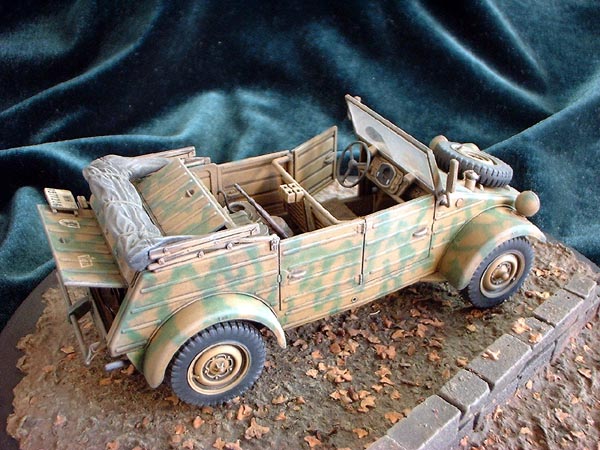
AFV Painting & Weathering
Answers to questions about the right paint scheme or tips for the right effect.
Answers to questions about the right paint scheme or tips for the right effect.
Hosted by Darren Baker, Matthew Toms
Painting Plaster Diorama kits
m60a3

Joined: March 08, 2002
KitMaker: 778 posts
Armorama: 396 posts

Posted: Wednesday, March 27, 2002 - 09:58 AM UTC
Can anyone recommend any good methods for painting plaster buildings? Any special tricks (sealing/priming)? This is a cherry jump for me, so any nudge out the door is appreciated... 

Posted: Wednesday, March 27, 2002 - 10:09 PM UTC
Bob,
I give my plaster buildings and accs. a couple of coats of dull coat to seal it,then a coat of primer,i use Krylon sandable primer from the hardware store.
I give my plaster buildings and accs. a couple of coats of dull coat to seal it,then a coat of primer,i use Krylon sandable primer from the hardware store.
GunTruck

Joined: December 01, 2001
KitMaker: 5,885 posts
Armorama: 3,799 posts

Posted: Wednesday, March 27, 2002 - 10:51 PM UTC

Bob - my advice might be unusual, but here goes:
I don't prime the plaster at all. I airbrush the paint on. I use acrylics, so they dry quickly. Get a section of broken plaster or a plaster concrete block and experiment. Once the paint is dry, I like to use diluted oils to weather and tint the parts of a plaster building - like staining on concrete. Apply it like you would a wash on a tank model - all the way from the small "pin" washes to the wide-brush washes depending on the surface area. If you experiment on a little section or concrete block, you'll get a handle on how much and where you want to apply the oils for staining. Since the plaster is pourous, it will absorb the wash quickly, allowing you to layer colors.
When that's dry, I then will go back with pastel chalks for surface weathering - a tiny bit goes a really long way if you did all the above. The little wall along side the Kubelwagen above was done this way - with one color, four washes of black and brown oils mixed in different ratios, and two colors of pastel chalks. It only took 5 minutes for the whole sequence.
Gunnie
ongjeff

KitMaker: 18 posts
Armorama: 0 posts
Posted: Thursday, March 28, 2002 - 01:26 AM UTC
Quoted Text
Hi, may I know how did u make the dried leaf in ur diorama? they look realistic!!
Bob - my advice might be unusual, but here goes:
I don't prime the plaster at all. I airbrush the paint on. I use acrylics, so they dry quickly. Get a section of broken plaster or a plaster concrete block and experiment. Once the paint is dry, I like to use diluted oils to weather and tint the parts of a plaster building - like staining on concrete. Apply it like you would a wash on a tank model - all the way from the small "pin" washes to the wide-brush washes depending on the surface area. If you experiment on a little section or concrete block, you'll get a handle on how much and where you want to apply the oils for staining. Since the plaster is pourous, it will absorb the wash quickly, allowing you to layer colors.
When that's dry, I then will go back with pastel chalks for surface weathering - a tiny bit goes a really long way if you did all the above. The little wall along side the Kubelwagen above was done this way - with one color, four washes of black and brown oils mixed in different ratios, and two colors of pastel chalks. It only took 5 minutes for the whole sequence.
Gunnie


GunTruck

Joined: December 01, 2001
KitMaker: 5,885 posts
Armorama: 3,799 posts

Posted: Thursday, March 28, 2002 - 01:36 AM UTC
Quoted Text
Hi, may I know how did u make the dried leaf in ur diorama? they look realistic!!

Wish I could take credit for making them!
 They're actually Fall Leaves from the Hudson & Allen line of diorama supplies. I think they're totally wonderful!
They're actually Fall Leaves from the Hudson & Allen line of diorama supplies. I think they're totally wonderful!Gunnie
Army

Joined: June 16, 2002
KitMaker: 96 posts
Armorama: 0 posts
Posted: Thursday, June 27, 2002 - 06:50 AM UTC
Very useful information.Thanks (also cherry) 

Folgore

Joined: May 31, 2002
KitMaker: 1,109 posts
Armorama: 0 posts
Posted: Thursday, June 27, 2002 - 07:43 AM UTC
For those leaves, would crumbling up some real leaves work? I thought it might, so last fall I saved a small bag of crunched up leaves incase I ever wanted to try it. The good thing with this technique, I would think, is that you would get a good variety of colour.
Nic
Nic
 |







